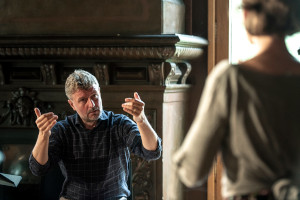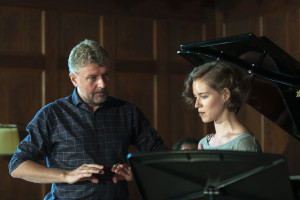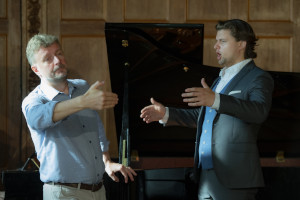



My Teaching Concept
My teaching concept consists of several important focal points:
Voice physiology and learning a safe singing technique
In order to bring singing technique, style, and personality in line in this short time, the teacher has to pay close attention to each student and define a tailor-made plan - especially for the students of the bachelor's degree. However, all students must first learn the basics of technique, only then can they work on different styles in the required repertoire.Breathing
Breathing is the source of energy for the production of vocal sound (phonation). Different muscle groups and organs work together when speaking or singing. Their coordination is an essential task. Speaking and singing are thus a synthesis of breathing, vocalisation and articulation. Good breathing while singing also depends on posture. This not only has a great influence on the respiratory system itself, but also on the diaphragm, larynx, neck muscles, and even the muscles of the face and the width of the nasal cavities.Upon inhalation, the diaphragm muscles and the outer intercostal muscles expand the chest. The diaphragm is pressed down and the abdominal wall bulges out. When practicing, breathing should always be done through the nose, which filters, humidifies and warms the air. If there is no rest and the singer is forced to gasp for air, inhalation can also be done with the help of a widening position (yawning) through the mouth and throat. The Italians call this quick way of breathing mezzorespiro.
When you exhale, the pressure under the glottis - also called subglottal pressure - blows the vocal cords apart and sets them vibrating. The air flowing out of the lungs makes the vocal folds vibrate during the vocalisation (phonation). This creates the primary sound at the larynx, which is then changed to speech and singing sounds through different resonance spaces. It is essential to practice breathing out slowly while singing and to use the air sparingly. The importance of learning the proper breathing technique is a constant topic of discussion. For me, the truth is in the middle. Learning "supported singing" is a development during which stopping the exhalation process plays a major role. “Singing on the breath” is easier said than done if the respiratory muscles fail a singer. This requires excellent physical fitness, which I demand from my students without exception, as the voice training process is very dependent on physical strength and breathing training. The work on a well-functioning "breath-voice coupling must, however, take place in small steps, continuously and parallel to the development of the vocal functions." (Pezenburg, Michael: Stimmbildung; Wißner; 2007)
Balancing the registers
I am of the opinion that every person has two registers: chest and head register. The exceptions here are the coloratura sopranos, who have an additional whistle register that needs to be strengthened. I refer to the so-called middle register as the middle range, a series of notes that are comfortably close to the speaking register (with the exception of very low-speaking basses or very high-speaking sopranos). However, I do not perceive these notes as a separate register. Chest and head registers are connected by a series of notes called the passaggio. It is important to adjust them so that the listener cannot perceive a break. One register is inherently stronger than the other. The weaker register should be strengthened through exercises so that both merge into one another in the passaggio. This always has to happen from top to bottom, never the other way around. Otherwise, you will pull up the weight of the chest register, which in turn leads to heaviness and inflexibility. The teacher has to plan a lot of time for this. At the same time, one should work on stretching the vocal range in both directions. In most cases this is achieved without any problems. The goal is therefore to develop an artistically usable singer's voice, which is balanced throughout the entire range. This balance must also include use of dynamics, which must be mastered in all areas from piano to forte. Similarly important here is the messa di voce function – the most important decoration of the old Italian and bel canto masters, i.e. the crescendoing and diminuendoing of long notes in all ranges of the voice. The light onset of the chest register gives the singer's sound lightness, the crescendoing in the head voice strengthens it and gives it increasing power. You then notice that in the Voix mixte, several notes (usually a fourth or fifth) are so balanced that you can hardly tell them apart.Balancing the vowels
Vowels are the main carriers of vocal sound. Balancing them leads to an increase in the volume and range of the voice, and even to an improvement in intonation. The different vowels have different characteristics. The vowel "i" has a lot of brightness and brings the voice to a forward placement, the "u" creates softness, headiness and roundness, and the "a" ensures the width. These characteristics of the vowels should lend some of their strengths to the others, so that all vowels of the respective sung language can end up rounded, soft, in front and, if possible, with the same open throat. The function of the tongue, the position of the larynx, the lips, and the lower jaw play an important role here. In my pedagogy I try not to use the term “covering” because it is often misinterpreted by the students and leads to irritation. Instead, I use the term "modification". I always associate the purity and clarity of the vowels with the pitch. This decides how much the sung vowel is modified. The higher the note sung, the more I look for its roundness and softness. However, there are small differences between the female and male voices. What works with a certain degree of openness for women (especially in the third octave), will often lead to problems with men. The only exceptions are the so-called Italian tenor voice and the voice of the dramatic tenor.Deliberate use of the vibrato function
The vibrato function of the human voice seems very natural, but it is a phenomenon that is little to be found in music treatises. In the last 150 years we can see a great development in sound possibilities. Fantastic compositions were created and volume became more important. However, all of this had catastrophic effects on the way of singing and the strain on the vocal organ. Not only did the Canto Fiorito die, but also the Belcanto. A singer was measured more and more by the "high C" and his or her vocal power. The vibrato function derailed. Each note was sung with tremolo vibrato, messa di voce was forgotten. A large and audible Vibrato prevailed until the rebirth of early music. Many conductors began to look for new sound ideals. The functions of third vibrato, tremolo, vibrato naturale and non-vibrato were recognised and openly discussed again. For me, however, it is clear that the vibrato naturale is very important and indispensable in the development of a healthy and well-functioning singer's voice. This slight, barely audible vibration of the human voice is proof of its vitality and lack of tension. This function must be balanced in all ranges and is therefore also proof of good breathing technique. Both vibrato and non-vibrato are functions that have to be mastered, and they are used differently in various musical styles. The difference between the polyphonic music of the 15th century, a virtuoso aria of the 18th century, a bel canto aria or a verismo operatic aria is enormous and should be differentiated and stylistically mastered by today's students. This has a lot to do with the learned vibrato function.Balancing the speech function with the singing function
In addition to well-produced sounds, a well-developed speaking function is the second most important element of every classical singer. Language enables us to formulate clear statements, which in turn, with the help of well-pronounced words, explain the state of the person or the situation. In everyday life, but also on stage, language represents the majority of communication. And in contrast to the language of the body (e.g. pantomime), it gives us the opportunity to disseminate a lot of information in the shortest possible time. It is only with the help of the language that singers are able to conduct dialogues and immerse themselves in the dramaturgy of the texts. It is not enough for the students to present the texts well; they should also be aware of their meaning. Only then does a good singer become a true performer. That is why every language sung should be understood and its pronunciation honed. In today's theatre scene, it is expected that the young singers speak several foreign languages and pronounce the languages sung on stage perfectly. These expectations have shown me many times that not only a well-trained voice, but also a free and relaxed approach to the language that is currently required are the prerequisites for a good career. The stage language should always be easy to understand, but only if the range of the sung works allows it. Speech that is too clearly formed, especially in the passaggio and in the high range, can lead to a narrowing of the vocal tract, but can also have a considerable influence on the sound of the voice (timbre). Therefore, I try to develop a language suitable for the stage with the students that represents a symbiosis with the clearly pronounced vowels. The pitch and its influence on the shape of the vowel always plays a decisive role.Individuality of a singer and its meaning
The voice is part of every human being and the best tool to express emotions and feelings. Just as there are different types of people such as sanguine, choleric, melancholic or phlegmatic, there are correspondingly different types of voices. We have light, dark, strong, weak, warm or cooler voices that almost always match the personalities of their owners. It is said that only happy children sing. I think that's true. The voice is a speaker of the soul. The personality expresses itself in the individual sound colour. This in turn makes a singer unmistakable. In order to be able to work successfully with the students, the teacher should not only pay attention to the voice, but also observe the personality and harmonise both. A conflict of voice and personality leads to failure.Building the stylistic expressiveness
After the students have learned to use the voice and have mastered the basics of vocal technique, the teacher should now pay more attention to stylistic perfection. Well-executed decorations, a wide range of dynamics and timbres, safe articulation and skilful use of the vibrato function represent the difference between a good and a professional singer for me. I try to cover as broad a spectrum as possible in the course of my teaching – of course, depending on the possibilities of the respective student. If you don't try things out a lot, you won't find out what a young singer's greatest strengths are. The flexibility of a voice and its colour will also influence any specialisation. Well-executed trills, meaningful cadences and ornaments sung in the style of the arias should be found in the music sung. I consider all of this to be very important, but it will not lead to the desired success if the voice sounds unbalanced, unrefined, sharp, with a limited range or with weak intonation.Development of the musical content-related expressiveness
Right from the start of a singer’s studies, I value the combination of voice and creative skills of my students. Apart from a few isolated technical and mechanical exercises, there should be no gap between vocal technique and musical and scenic expression. In every work, be it aria, recitative, ensemble or song, we have the task of looking for the artistic message of the piece, tracking it down and then implementing it. It is important to stimulate the students' imagination, to encourage them to look for the “meaning behind the meaning”, the subtext of a piece, and to put it in context with the musical environment of the work to be developed. Even "supposedly simple" exercises by Nikola Vaccai should be carried out with musical gesture and sense, with more demanding literature this task becomes more interesting and challenging. This also includes working together with musical partners on the piano, in the orchestra, etc. Ultimately, the control and beauty of the voice is at the service of the artistic statement.Professional recordings, photos and media presence
For several years, professionally-produced recordings of the students have played an increasingly important role. There are hardly any competitions, festivals or masterclasses that young artists can apply for without a digital preliminary round. This is why I try to start with the first recordings, supervised by a sound engineer, during the bachelor's degree. Anyone who has already recorded CDs or DVDs will know what precision and reliability of sound creation is expected in this form of work. The earlier you deal with this special form of work, the faster you will be up to the task. Decent artistic portraits are also essential for a successful application. I belong to the generation that did not grow up with social media. This digital world is dangerous, but also offers great opportunities that can be useful for your career. How actively the students use these platforms, however, depends on their personal attitude towards this topic. Still, a successful career is primarily based on the artistic qualities of a singer and not necessarily on their media presence.
Résumé
In the description of my concept for the training of singing students, the order of the steps mentioned is particularly important to me. If, during the studies, I determine that the student has reached a point where he or she could be on the stage, I introduce them to one of the agencies I know. The agents trust my quality assessment, appreciate the trusting cooperation and at the same time, make it easier for my students to access auditions at opera houses and with concert organisers. Through my many years of solid teaching, I’ve been able to train many very good singers and send them to work in this industry. Working on the details of singing technique, on informed style, and the search for appropriate literature gives me great pleasure and spurs me on to continue my education and to deepen my own knowledge.
Marek Rzepka
Frankfurt am Main
February 2021
Content
- Voice physiology and learning a safe singing technique
- Breathing
- Balancing the registers
- Balancing the vowels
- Deliberate use of the vibrato function
- Balancing the speech function with the singing function
- Individuality of a singer and its meaning
- Building the stylistic expressiveness
- Development of the musical content-related expressiveness
- Professional recordings, photos and media presence
- Résumé

